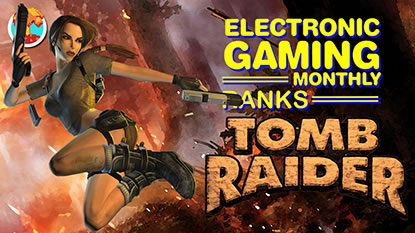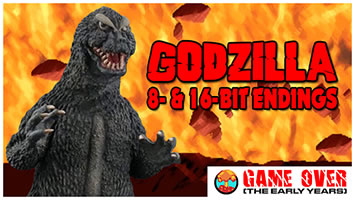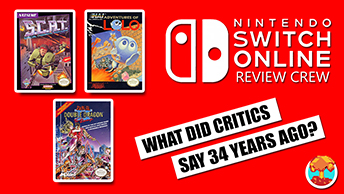- CLASSIC MAGAZINES
- REVIEW CREW
A show recapping what critics thought back
when classic games first came out! - NEXT GENERATION'S BEST & WORST
From the worst 1-star reviews to the best
5-stars can offer, this is Next Generation! - NINTENDO POWER (ARCHIVE)
Experience a variety of shows looking at the
often baffling history of Nintendo Power! - MAGAZINE RETROSPECTIVE
We're looking at the absolutely true history of
some of the most iconic game magazines ever! - SUPER PLAY'S TOP 600
The longest and most ambitious Super NES
countdown on the internet! - THEY SAID WHAT?
Debunking predictions and gossip found
in classic video game magazines! - NEXT GENERATION UNCOVERED
Cyril is back in this spin-off series, featuring the
cover critic review the art of Next Generation! - HARDCORE GAMER MAGAZING (PDF ISSUES)
Download all 36 issues of Hardcore Gamer
Magazine and relive the fun in PDF form!
- REVIEW CREW
- ELECTRONIC GAMING MONTHLY
- ELECTRONIC GAMING MONTHLY RANKS
From Mario to Sonic to Street Fighter, EGM
ranks classic game franchises and consoles! - ELECTRONIC GAMING MONTHLY BEST & WORST
Counting down EGM’s best and worst reviews
going year by year, from 1989 – 2009! - ELECTRONIC GAMING BEST & WORST AWARDS
11-part video series chronicling the ups and
downs of EGM’s Best & Worst Awards!
- ELECTRONIC GAMING MONTHLY RANKS
- GAME HISTORY
- GAME OVER: STORY BREAKDOWNS
Long-running series breaking down game
stories and analyzing their endings! - A BRIEF HISTORY OF GAMING w/ [NAME HERE]
Real history presented in a fun and pithy
format from a variety of game historians! - THE BLACK SHEEP
A series looking back at the black sheep
entries in popular game franchises! - INSTANT EXPERT
Everything you could possibly want to know
about a wide variety of gaming topics! - FREEZE FRAME
When something familiar happens in the games
industry, we're there to take a picture! - I'VE GOT YOUR NUMBER
Learn real video game history through a series
of number-themed episodes, starting at zero! - GREAT MOMENTS IN BAD ACTING
A joyous celebration of some of gaming's
absolute worst voice acting!
- GAME OVER: STORY BREAKDOWNS
- POPULAR SHOWS
- DG NEWS w/ LORNE RISELEY
Newsman Lorne Riseley hosts a regular
series looking at the hottest gaming news! - REVIEW REWIND
Cyril replays a game he reviewed 10+ years
ago to see if he got it right or wrong! - ON-RUNNING FEUDS
Defunct Games' longest-running show, with
editorials, observations and other fun oddities! - DEFUNCT GAMES QUIZ (ARCHIVE)
From online quizzes to game shows, we're
putting your video game knowledge to the test!- QUIZ: ONLINE PASS
Take a weekly quiz to see how well you know
the news and current gaming events! - QUIZ: KNOW THE GAME
One-on-one quiz show where contestants
find out if they actually know classic games! - QUIZ: THE LEADERBOARD
Can you guess the game based on the classic
review? Find out with The Leaderboard!
- QUIZ: ONLINE PASS
- DEFUNCT GAMES VS.
Cyril and the Defunct Games staff isn't afraid
to choose their favorite games and more! - CYRIL READS WORLDS OF POWER
Defunct Games recreates classic game
novelizations through the audio book format!
- DG NEWS w/ LORNE RISELEY
- COMEDY
- GAME EXPECTANCY
How long will your favorite hero live? We crunch
the numbers in this series about dying! - VIDEO GAME ADVICE
Famous game characters answer real personal
advice questions with a humorous slant! - FAKE GAMES: GUERILLA SCRAPBOOK
A long-running series about fake games and
the people who love them (covers included)! - WORST GAME EVER
A contest that attempts to create the worst
video game ever made, complete with covers! - LEVEL 1 STORIES
Literature based on the first stages of some
of your favorite classic video games! - THE COVER CRITIC
One of Defunct Games' earliest shows, Cover
Critic digs up some of the worst box art ever! - COMMERCIAL BREAK
Take a trip through some of the best and
worst video game advertisements of all time! - COMIC BOOK MODS
You've never seen comics like this before.
A curious mix of rewritten video game comics!
- GAME EXPECTANCY
- SERIES ARCHIVE
- NINTENDO SWITCH ONLINE ARCHIVE
A regularly-updated list of every Nintendo
Switch Online release, plus links to review! - PLAYSTATION PLUS CLASSIC ARCHIVE
A comprehensive list of every PlayStation
Plus classic release, including links! - RETRO-BIT PUBLISHING ARCHIVE
A regularly-updated list of every Retro-Bit
game released! - REVIEW MARATHONS w/ ADAM WALLACE
Join critic Adam Wallace as he takes us on a
classic review marathon with different themes!- DEFUNCT GAMES GOLF CLUB
Adam Wallace takes to the links to slice his way
through 72 classic golf game reviews! - 007 IN PIXELS
Adam Wallace takes on the world's greatest spy
as he reviews 15 weeks of James Bond games! - A SALUTE TO VAMPIRES
Adam Wallace is sinking his teeth into a series
covering Castlevania, BloodRayne and more! - CAPCOM'S CURSE
Adam Wallace is celebrating 13 days of Halloween
with a line-up of Capcom's scariest games! - THE FALL OF SUPERMAN
Adam Wallace is a man of steel for playing
some of the absolute worst Superman games! - THE 31 GAMES OF HALLOWEEN
Adam Wallace spends every day of October afraid
as he reviews some of the scariest games ever! - 12 WEEKS OF STAR TREK
Adam Wallace boldly goes where no critic has
gone before in this Star Trek marathon!
- DEFUNCT GAMES GOLF CLUB
- DAYS OF CHRISTMAS (ARCHIVE)
Annual holiday series with themed-episodes
that date all the way back to 2001!- 2015: 30 Ridiculous Retro Rumors
- 2014: 29 Magazines of Christmas
- 2013: 29 Questionable Power-Ups of Christmas
- 2012: 34 Theme Songs of Christmas
- 2011: 32 Game Endings of Christmas
- 2010: 31 Bonus Levels of Christmas
- 2009: 30 Genres of Christmas
- 2008: 29 Controls of Christmas
- 2007: 34 Cliches of Christmas
- 2006: 33 Consoles of Christmas
- 2005: 32 Articles of Christmas
- 2004: 31 Websites of Christmas
- 2003: 29 Issues of Christmas
- 2002: 28 Years of Christmas
- 2001: 33 Days of Christmas
- NINTENDO SWITCH ONLINE ARCHIVE
- REVIEW ARCHIVE
- FULL ARCHIVE
Five Famous Characters That Called it Quits
Instant Expert is back with all new episodes designed to quickly turn you into a video game historian. With its humorous bent, Instant Expert makes learning easy and fun. Make sure and subscribe to the Defunct Games YouTube Channel for even more history lessons!
David Caruso, Shelly Long and David Duchovny all have one thing in common; they left their TV shows early. It's that awkward moment when the main star leaves, but the show must go on. In the case of Caruso, NYPD went on for another ten seasons. Shelly Long ditched Cheers six seasons before the end. And David Duchovny probably made the right decision by skipping two unwatchable years of The X-Files.
It's not just big Hollywood stars that quit at the height of their success; video game heroes have been known to take an early retirement. In fact, some of the most beloved game characters of all time have called it quits, forcing somebody else to take over. Let's see if you're favorite star is a quitter when we look at the Five Famous Characters that Called it Quits.
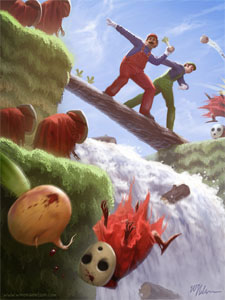
Super Mario 64? But here's the shocking truth: Super Mario is as much a quitter as Richard Nixon ever was.
By 1994, Mario had already starred in a bunch of iconic 8-bit platformers, as well as 16-bit remakes of those iconic 8-bit platformers. Mario had conquered the Game Boy, Super NES launch and was about to be used to sell the Virtual Boy and Nintendo 64 consoles. And don't forget about the movies, TV shows and cartoons. With so many projects going at once, it's no wonder Mario decided to drop one of his franchises.
After starring in two well-received Super Mario Land games, the Italian plumber decided to skip out on Super Mario Land 3. In his place was a new character, the ornery cheapskate, Wario. This new direction was a hit, and Wario Land spawned several sequels and spin-offs. Wario's popularity continues to grow, thanks to new games like Game & Wario on the Wii U. And all this happened because Mario decided to quit.
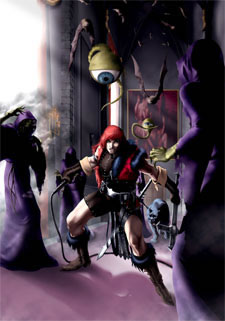
creates a castle out of thin air and tries to kill you. Trust me, that's much worse than your loveless marriage and blowhard boss.
For years, Simon Belmont was the face of Castlevania. Not only did he stake Dracula in the 1987 original, but Simon made it a point to hunt vampires in Castlevania II: Simon's Quest, Super Castlevania IV, Haunted Castle and the appropriately named Vampire Killer. Simon was so popular that he ended up being one of the stars of the Captain N television series. But after several bouts with Drac, Simon hung up his whip and officially retired from the Castlevania franchise.
Trevor Belmont was the first to take over. Then Ritcher and Alucard. These days the Castlevania franchise is a revolving door for unique characters. You have Nathan Graves, Juste Belmont, Leon Belmont, Gabriel Belmont, the list goes on and on. At this point it would be easier to talk about the characters who haven't starred in a Castlevania game. But with more than 24 games in the in the last two decades, it doesn't look like Konami misses the old star of Castlevania.
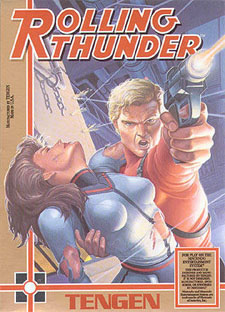
Leila Blitz from a secret organization named Geldra. Thankfully he saves the day, though it looked dicey when his gun started shooting the world's slowest bullets.
In Rolling Thunder 2, Leila teams up with Albatross to finish the fight. In the process, the two fall madly in love and decide to run off to an undisclosed location. They don't even notify their employer, the World Crime Police Organization; they simply drop off the grid completely.
Instead of leaving the Rolling Thunder story there, Namco decided to continue the series without the star. Subbing for Albatross is a brand new agent codenamed Jay. No, not like the letter "J". His codename is Jay like Jay Leno. Like Jay Mohr. Like the O'Jays. But not like OJ.
Much like the newest Bourne movie, the actions in Rolling Thunder 3 take place at the exact same time as Rolling Thunder 2. That way Namco could get away with making a sequel that had nothing to do with Albatross. Unfortunately, this was the last Rolling Thunder game. It ends with Agent Jay getting blown up and us never hearing from Albatross again. How do you like those apples?
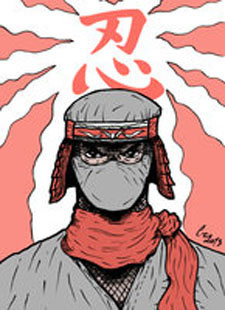
been as cute and cuddly as Wonder Boy or Alex Kidd, Sega had no problem using Joe's face to move consoles.
Between 1987 and 1993, Joe found himself in five different games. You may remember him from the original Shinobi, The Revenge of Shinobi, the Game Gear Shinobi, The Silent Fury and, of course, Return of the Ninja Masters. After Shinobi III, Joe called it quits.
Games like Shadow Dancer, Shinobi 3D, The Secret of Shinobi and The Cyber Shinobi all feature Musashi descendants, and Shinobi Legion chronicles a completely unrelated hero named Sho. Even Sega's 2002 Shinobi reboot opted for somebody other than Joe Musashi. This is Hotsuma the new star of Shinobi, and this is Hibana, the protagonist of the Shinobi spin-off Nightshade.
Somewhere in this giant world, Joe Musashi enjoys his retirement by completely ignoring what has become of the Shinobi name. He put in his years, now it's time for the new generation to take over. Maybe one of these times Sega will get it right.
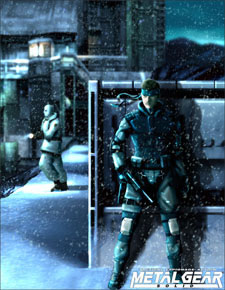
to name him one of the greatest video game heroes of all time and even TV shows began to emulate Snake's no-holds-barred brand of tactical espionage action.
But then a funny thing happened. Just as Solid Snake was at his most popular, he walked away from the Metal Gear Solid franchise. Although Snake makes a brief appearance in Metal Gear Solid 2, Sons of Liberty ends up being a story about a brand new character named Raiden. Metal Gear Solid 3 brought us yet another character, Big Boss (aka Naked Snake), who also starred in Peace Walker, Portable Ops and the upcoming sequel, The Phantom Pain. At this point Big Boss has been in more games than the so-called star of Metal Gear Solid.
To his credit, Solid Snake did return for Metal Gear Solid 4: Guns of the Patriot, where he played a rapidly aging hero on one final mission. But alas, all this did was prove what many already thought. Naked Snake is a far more interesting character living in a much more intriguing era. Big Boss is conflicted, often being forced to toe the line between hero and traitor. He lived through a time when there was still mystery to the world. Solid Snake is just a clone. As far as I can tell, Big Boss is the real star of Metal Gear Solid.
It's not just big Hollywood stars that quit at the height of their success; video game heroes have been known to take an early retirement. In fact, some of the most beloved game characters of all time have called it quits, forcing somebody else to take over. Let's see if you're favorite star is a quitter when we look at the Five Famous Characters that Called it Quits.
Mario (Super Mario Land)
When you think Super Mario, you probably don't think quitter. If anything, this is a guy who sticks with things until everybody is sick and tired of him. How else do you explain Mario Party 8, Mario Kart 8 and

By 1994, Mario had already starred in a bunch of iconic 8-bit platformers, as well as 16-bit remakes of those iconic 8-bit platformers. Mario had conquered the Game Boy, Super NES launch and was about to be used to sell the Virtual Boy and Nintendo 64 consoles. And don't forget about the movies, TV shows and cartoons. With so many projects going at once, it's no wonder Mario decided to drop one of his franchises.
After starring in two well-received Super Mario Land games, the Italian plumber decided to skip out on Super Mario Land 3. In his place was a new character, the ornery cheapskate, Wario. This new direction was a hit, and Wario Land spawned several sequels and spin-offs. Wario's popularity continues to grow, thanks to new games like Game & Wario on the Wii U. And all this happened because Mario decided to quit.
Simon Belmont (Castlevania)
Think you have problems? Think again, because they're nothing compared to being a Belmont. First you have to train how to use a whip and then every one hundred years, Dracula

For years, Simon Belmont was the face of Castlevania. Not only did he stake Dracula in the 1987 original, but Simon made it a point to hunt vampires in Castlevania II: Simon's Quest, Super Castlevania IV, Haunted Castle and the appropriately named Vampire Killer. Simon was so popular that he ended up being one of the stars of the Captain N television series. But after several bouts with Drac, Simon hung up his whip and officially retired from the Castlevania franchise.
Trevor Belmont was the first to take over. Then Ritcher and Alucard. These days the Castlevania franchise is a revolving door for unique characters. You have Nathan Graves, Juste Belmont, Leon Belmont, Gabriel Belmont, the list goes on and on. At this point it would be easier to talk about the characters who haven't starred in a Castlevania game. But with more than 24 games in the in the last two decades, it doesn't look like Konami misses the old star of Castlevania.
Albatross (Rolling Thunder)
Named for the bird made famous by Samuel Taylor Coleridge, Albatross is best known as the athletically gifted hero of Rolling Thunder. In the first game he's tasked with saving

In Rolling Thunder 2, Leila teams up with Albatross to finish the fight. In the process, the two fall madly in love and decide to run off to an undisclosed location. They don't even notify their employer, the World Crime Police Organization; they simply drop off the grid completely.
Instead of leaving the Rolling Thunder story there, Namco decided to continue the series without the star. Subbing for Albatross is a brand new agent codenamed Jay. No, not like the letter "J". His codename is Jay like Jay Leno. Like Jay Mohr. Like the O'Jays. But not like OJ.
Much like the newest Bourne movie, the actions in Rolling Thunder 3 take place at the exact same time as Rolling Thunder 2. That way Namco could get away with making a sequel that had nothing to do with Albatross. Unfortunately, this was the last Rolling Thunder game. It ends with Agent Jay getting blown up and us never hearing from Albatross again. How do you like those apples?
Joe Musashi (Shinobi)
Like Call of Duty players and casual misogyny, ninjas and video games are a perfect fit. One of the earliest ninja stars was none other than Joe Musashi, the hero of Sega's Shinobi franchise. In the arcades, on 8-bit systems and in a number of popular Genesis games, Joe Musashi was a big deal in the late 80s and early 90s. And while he may never have

Between 1987 and 1993, Joe found himself in five different games. You may remember him from the original Shinobi, The Revenge of Shinobi, the Game Gear Shinobi, The Silent Fury and, of course, Return of the Ninja Masters. After Shinobi III, Joe called it quits.
Games like Shadow Dancer, Shinobi 3D, The Secret of Shinobi and The Cyber Shinobi all feature Musashi descendants, and Shinobi Legion chronicles a completely unrelated hero named Sho. Even Sega's 2002 Shinobi reboot opted for somebody other than Joe Musashi. This is Hotsuma the new star of Shinobi, and this is Hibana, the protagonist of the Shinobi spin-off Nightshade.
Somewhere in this giant world, Joe Musashi enjoys his retirement by completely ignoring what has become of the Shinobi name. He put in his years, now it's time for the new generation to take over. Maybe one of these times Sega will get it right.
Solid Snake (Metal Gear Solid)
After his explosive showdown at Shadow Moses, there was no question that Solid Snake was the star of Metal Gear Solid. Magazines and websites from around the world were quick

But then a funny thing happened. Just as Solid Snake was at his most popular, he walked away from the Metal Gear Solid franchise. Although Snake makes a brief appearance in Metal Gear Solid 2, Sons of Liberty ends up being a story about a brand new character named Raiden. Metal Gear Solid 3 brought us yet another character, Big Boss (aka Naked Snake), who also starred in Peace Walker, Portable Ops and the upcoming sequel, The Phantom Pain. At this point Big Boss has been in more games than the so-called star of Metal Gear Solid.
To his credit, Solid Snake did return for Metal Gear Solid 4: Guns of the Patriot, where he played a rapidly aging hero on one final mission. But alas, all this did was prove what many already thought. Naked Snake is a far more interesting character living in a much more intriguing era. Big Boss is conflicted, often being forced to toe the line between hero and traitor. He lived through a time when there was still mystery to the world. Solid Snake is just a clone. As far as I can tell, Big Boss is the real star of Metal Gear Solid.
HOME |
CONTACT |
NOW HIRING |
WHAT IS DEFUNCT GAMES? |
NINTENDO SWITCH ONLINE |
RETRO-BIT PUBLISHING
Retro-Bit |
Switch Planet |
The Halcyon Show |
Same Name, Different Game |
Dragnix |
Press the Buttons
Game Zone Online | Hardcore Gamer | The Dreamcast Junkyard | Video Game Blogger
Dr Strife | Games For Lunch | Mondo Cool Cast | Boxed Pixels | Sega CD Universe | Gaming Trend
Game Zone Online | Hardcore Gamer | The Dreamcast Junkyard | Video Game Blogger
Dr Strife | Games For Lunch | Mondo Cool Cast | Boxed Pixels | Sega CD Universe | Gaming Trend
Copyright © 2001-2024 Defunct Games
All rights reserved. All trademarks are properties of their respective owners.
All rights reserved. All trademarks are properties of their respective owners.













